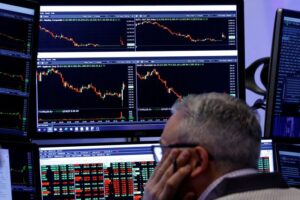Market Turbulence: Analyzing the Recent U.S. Stock Selloff
The recent downturn in major U.S. stock indexes has left investors and analysts pondering the implications of current economic and political environments. Following U.S. President Donald Trump’s ambiguous remarks about potential tariffs and their impact on the economy, market sentiment took a considerable hit. The Nasdaq Composite experienced a significant drop of over 3%, confirming that its retreat from the record highs of December was indeed a market correction. Meanwhile, the S&P 500 slid by 2%, now hovering approximately 8% below its all-time peak reached on February 19.
The Underlying Causes of Market Anxiety
As we analyze the motivations behind the selloff, several industry voices offer perspectives that shed light on the prevailing market dynamics.
Dan Coatsworth, Investment Analyst at AJ Bell in London, highlighted a growing unease about elevated equity valuations that had long been predicted to trigger a market correction. With critical factors such as trade wars, geopolitical uncertainty, and an ambiguous economic outlook at play, Coatsworth believes these all contribute to a rising sense of impending turmoil. He emphasized that Trump’s earlier image as an economic savior has morphed into a potential “harbinger of doom” due to recent trade tariff concerns.
The Impact of Uncertainty on Strategic Investments
In the wake of these shifts, Michael O’Rourke, Chief Market Strategist at JonesTrading, pointed out that the expectations surrounding Trump’s presidency had set a high bar for market conditions. However, the structural changes he is attempting to implement may be causing enough friction to fuel investor apprehension, leading many to take profits. O’Rourke suggests that this environment has led investors to reconsider alternatives beyond U.S. markets, where valuations are lower and growth might be more sustainable.
Idanna Appio, Portfolio Manager at First Eagle Investment Management, reinforced this sentiment by stating that growing uncertainty surrounding U.S. policy is becoming detrimental to business decisions, making it increasingly challenging for companies to strategize investments.
Sentiment Shift and the Broader Implications
Several analysts reflected on the drastic sentiment shift among investors. Jamie Cox, Managing Partner at Harris Financial Group, noted that worries around the debt ceiling are manifesting as fears of slowed growth, indicating that the current climate creates a unique opportunity for sentiment reversion. Markets could bounce positively at the slightest hint of good news, suggesting a fragile balancing act between optimism and pessimism.
In this context, Ayako Yoshioka, Senior Investment Strategist at Wealth Enhancement observed a pronounced trend where previously outperforming growth stocks are facing significant downward pressure, leading investors to reassess their portfolios in light of increased market volatility and uncertainty.
Tech Stocks Under the Microscope
Art Hogan, Chief Market Strategist at B Riley Wealth, mentioned that the narrative around tariffs has become a focal point of market anxiety, especially impacting technology stocks that are typically more sensitive to risk sentiment. As these stocks have seen elevated valuations, the selloff in the Nasdaq indicates a level of de-risking that many investors are currently executing.
Chris Zaccarelli, Chief Investment Officer at Northlight Asset Management, noted a consistent pattern of risk aversion within the Nasdaq, attributing it to the combination of overvaluation and increased uncertainty typical in today’s landscape. This perspective aligns with Thomas Hayes, Chairman at Great Hill Capital, who advocated for a broader focus on macroeconomic indicators—like Japanese government bond yields—over immediate tariff concerns, positioning these financial variables as influential in shaping market behavior.
Conclusion: Navigating a Shifting Market Landscape
In summary, while the current U.S. market atmosphere may seem precarious, there are valuable lessons to be learned for both investors and industry watchers. Monitoring global economic indicators alongside domestic political developments will be essential as the landscape continues to evolve. This analysis underlines the importance of staying informed and flexible in investment strategies, especially in a time defined by volatility and uncertainty.
To keep abreast of these developments, and explore actionable investment strategies with our expert insights, follow Extreme Investor Network as we navigate the intricacies of today’s financial markets together.

